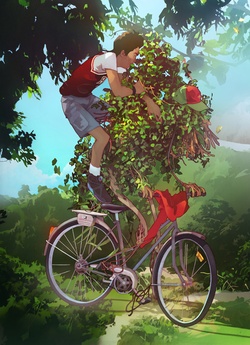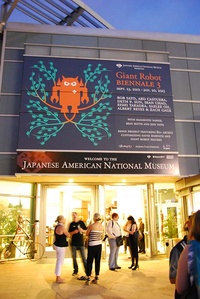“The opening was mind-blowing,” says Clement Hanami. “People came out of the woodwork to see this show. We had lines trying to get in and the galleries were packed.”
Hanami is recalling the Japanese American National Museum’s landmark 2007 exhibition, Giant Robot Biennale: 50 Issues, which inaugurated the Museum’s long-running and successful Salon Pop program series. Salon Pop explores the creative talents of Asians and/or Asian Americans whose unique and innovative work is currently having an impact on American popular culture.
“Running around, I came across a gentleman with a young daughter about 14 years old, asking for the way to the exhibition,” says Hanami. “I stopped and found out that this father and his parents used to be supporters of the Museum but that he had lost contact after his parents passed away. Now he was back because his daughter had asked to be brought here to see this show.”
“He really wondered why he had lost this connection in the first place,” Hanami notes. “And he was glad to be back.”
That example of reconnecting with younger generations, says Hanami, illustrates one of the reasons that the Museum has continued the Salon Pop series, which was launched with a major grant from The James Irvine Foundation.
Hanami is preparing the series’ next exhibition, Supernatural: The Art of Audrey Kawasaki, Edwin Ushiro, and Timothy Teruo Watters, that features the work of three Japanese American contemporary artists. With inspirations ranging from the spirits of beloved relatives to horror manga to Japanese ghost stories, the art in Supernatural explores otherworldly themes in colorful and evocative ways.
The three featured artists in Supernatural, says Hanami, are representatives of the next wave of creative American talents who are influencing their field—and resonating strongly with younger audiences.
“I was charged with developing some type of program that would focus on bringing young and more diverse groups to the Museum,” says Hanami, reflecting back on Salon Pop’s beginnings in 2007. “The pop culture-themed Takashi Murakami exhibition was garnering great excitement next door, at the Geffen Contemporary at MOCA, and so I thought about ways to tie into this phenomena with Japanese Americans and their impact in our local communities. Eric Nakamura (of Giant Robot) and (artist/musician) Mike Shinoda were two classic examples at the time, and so with them in mind, the museum developed Salon Pop.”
“Once this concept was in place, we also developed new ways of working,” says Hanami. “Unlike the traditional museum model, we worked in more of a producer model where I was the person that worked with specific art and cultural ‘mavens’ and helped to ensure that their content stayed within the messaging of the Museum so that it wasn’t completely foreign to our visitors. So with my role as ‘gatekeeper,’ the process of building exhibitions became very dynamic and collaborative in that selections were formed and then vetted amongst key stakeholders, and opportunities were sought out for the most beneficial fit within our overall goals for the program and the museum.”
“With the Giant Robot exhibitions, we liked the idea of Japanese Americans or other Asian Americans within the show, but we also liked the idea of multiethnic representation,” Hanami says. “In the end, I think we looked for an even balance of individuals and genders, as well as artistic qualities and genres.”
Kawasaki, Ushiro, and Watters are all artists that are currently developing their work within the Los Angeles area, Hanami explains. Through exhibitions such as Supernatural and the Salon Pop programs, the Museum is developing a myriad of relationships with these young artists and curators creating a unique opportunity to connect with new and diverse audiences. Through it all, Hanami notes, Eric Nakamura has been a close artistic partner and ally of the Museum.
While clearly appealing to younger generations, the resulting exhibitions have provoked a sometimes interesting range of reactions and discussion, especially among the Museum’s older audiences.
“Those that enjoy the show, regardless of tastes, are drawn by the playfulness and experimentation of Salon Pop,” says Hanami. “But there are also those that do not always understand why these exhibitions are here at the Museum. That is a constant challenge that we attempt to address through our video presentations, Guide by Cell (supplemental audio tours accessible by cell phones), and textual elements. We aim to provide those not sure about Salon Pop an articulate reasoning as to why this exists at JANM.”
“I think, if anything, the Museum has benefited from the younger perspective,” says Hanami. “It needs to engage this group as the eventual next generation of supporters and leaders. If the Museum is to continue in the future, the next generation has to take that role, and for them to embrace that, they need to start by seeing that their visions and voices are a part of this institution.”
Those voices, Hanami explains, are important for nurturing appreciation of cultural diversity—most notably, for understanding that within each ethnic group there is an endless variety of perspectives and subcultures.
“The general public does not always have a full appreciation of the deep complexities that exist in every culture in America,” says Hanami. “Hopefully our Salon Pop exhibitions help to provide deeper, more fully articulated visions of what it means to be an American of a specific ethnic group or culture. And in doing so, we will create a better understanding of the complexity of the American identity.”
* * * * *
Supernatural: The Art of Audrey Kawasaki, Edwin Ushiro, and Timothy Teruo Watters
February 9 – March 17, 2013
Japanese American National Museum
Los Angeles, California
Traditions are an integral part of every community. Some of these come from superstitions that our ancestors carried with them.
Supernatural features the work of Audrey Kawasaki, Edwin Ushiro, and Timothy Teruo Watters who have explored some of these otherworldly concepts, illustrating how traditional ideas have evolved and been adapted over time.
For more information about the exhibition >>
@ 2013 Japanese American National Museum









